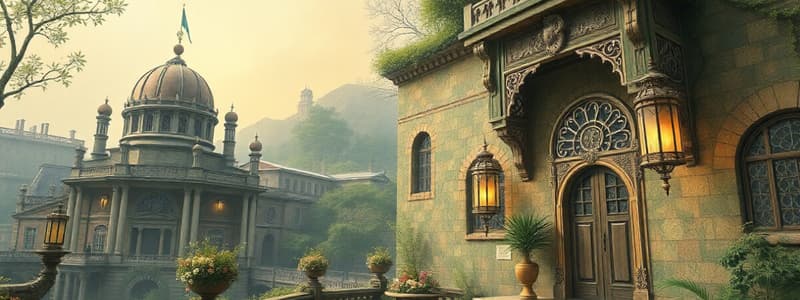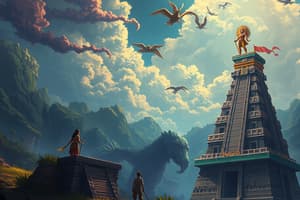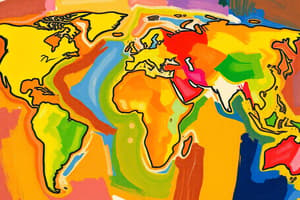Podcast
Questions and Answers
Which philosophy emphasizes hierarchical social order and moral governance among leaders?
Which philosophy emphasizes hierarchical social order and moral governance among leaders?
- Legalism
- Daoism
- Confucianism (correct)
- Buddhism
Ashoka was instrumental in the spread of Jainism in India.
Ashoka was instrumental in the spread of Jainism in India.
False (B)
What was the primary impact of Alexander the Great on the Mediterranean world?
What was the primary impact of Alexander the Great on the Mediterranean world?
He spread Hellenistic culture across various regions.
The caste system is a key feature of ______ in India.
The caste system is a key feature of ______ in India.
Match the following emperors with their respective dynasties:
Match the following emperors with their respective dynasties:
What was one primary effect of the spread of Islam through ocean trade?
What was one primary effect of the spread of Islam through ocean trade?
The Hagia Sophia was built during the rule of Emperor Justinian and served as a cathedral then a mosque.
The Hagia Sophia was built during the rule of Emperor Justinian and served as a cathedral then a mosque.
What major legal framework did Emperor Justinian establish to systematize laws in the Byzantine Empire?
What major legal framework did Emperor Justinian establish to systematize laws in the Byzantine Empire?
The _____ is one of the primary universal religions that developed during the post-classical period, alongside Christianity and Buddhism.
The _____ is one of the primary universal religions that developed during the post-classical period, alongside Christianity and Buddhism.
Match the following terms with their correct descriptions:
Match the following terms with their correct descriptions:
What is the total number of multiple-choice questions on the AP World midterm?
What is the total number of multiple-choice questions on the AP World midterm?
Students are only responsible for vocabulary words defined in class contexts on the day of the midterm.
Students are only responsible for vocabulary words defined in class contexts on the day of the midterm.
What fundamental changes did the Neolithic Revolution bring about in human society?
What fundamental changes did the Neolithic Revolution bring about in human society?
The significant ancient text that includes laws is called the _____ of Hammurabi.
The significant ancient text that includes laws is called the _____ of Hammurabi.
How many short-answer questions (SAQs) will be included in the AP World midterm?
How many short-answer questions (SAQs) will be included in the AP World midterm?
Match the following river valley civilizations with their key characteristics:
Match the following river valley civilizations with their key characteristics:
Extra help sessions are available only on specific scheduled days for each teacher.
Extra help sessions are available only on specific scheduled days for each teacher.
Name one key aspect of river valley civilizations.
Name one key aspect of river valley civilizations.
Which concept refers to the legitimacy of ruling power in Classical China?
Which concept refers to the legitimacy of ruling power in Classical China?
What was a significant achievement of the Gupta Dynasty in India?
What was a significant achievement of the Gupta Dynasty in India?
What political structure is most closely associated with the Maurya Dynasty?
What political structure is most closely associated with the Maurya Dynasty?
In what way did the Roman Empire's achievements compare with those of Han China?
In what way did the Roman Empire's achievements compare with those of Han China?
Which of the following best describes the role of trade in the classical civilizations?
Which of the following best describes the role of trade in the classical civilizations?
What was a significant change in the role of gender from pre-Islamic Arabia to the Umayyad period?
What was a significant change in the role of gender from pre-Islamic Arabia to the Umayyad period?
Which statement about the Byzantine Empire is accurate regarding its legal system?
Which statement about the Byzantine Empire is accurate regarding its legal system?
What distinguishes a universal religion from an ethnic religion?
What distinguishes a universal religion from an ethnic religion?
What was a primary method for the spread of Islam during the post-classical period?
What was a primary method for the spread of Islam during the post-classical period?
How did the role of the Church influence Western Europe after the Fall of the Roman Empire?
How did the role of the Church influence Western Europe after the Fall of the Roman Empire?
What is the total number of short-answer questions on the AP World midterm?
What is the total number of short-answer questions on the AP World midterm?
Which component is NOT required to bring to the AP World midterm?
Which component is NOT required to bring to the AP World midterm?
What is a recommended study method for preparing for the AP World midterm?
What is a recommended study method for preparing for the AP World midterm?
Which of the following is a key characteristic of river valley civilizations?
Which of the following is a key characteristic of river valley civilizations?
When is the review session for the AP World midterm scheduled?
When is the review session for the AP World midterm scheduled?
What should students do during extra help sessions?
What should students do during extra help sessions?
Which major text includes a set of laws relevant to ancient civilizations?
Which major text includes a set of laws relevant to ancient civilizations?
How many multiple-choice questions will be included in the AP World midterm?
How many multiple-choice questions will be included in the AP World midterm?
Flashcards
Neolithic Revolution
Neolithic Revolution
The process of humans moving from hunting and gathering wild foods to cultivating and harvesting crops and domesticating animals. This transition, starting around 10,000 BCE, led to significant lifestyle changes, including settled communities, surplus food, and the emergence of specialized labor.
River Valley Civilizations
River Valley Civilizations
The period of significant technological advancement and societal transformation starting around 3000 BCE, marked by the development of urban centers, writing systems, complex social hierarchies, specialized labor, and organized government institutions. Examples include Mesopotamia, Egypt, Indus Valley, and Shang China.
Code of Hammurabi
Code of Hammurabi
A collection of laws and punishments inscribed on a large stone pillar in ancient Mesopotamia, outlining the rules and consequences for various offenses. It provides valuable insights into social structures and legal practices of the time.
Epic of Gilgamesh
Epic of Gilgamesh
Signup and view all the flashcards
Ten Commandments
Ten Commandments
Signup and view all the flashcards
Major Characteristics of Civilizations
Major Characteristics of Civilizations
Signup and view all the flashcards
Classical Period
Classical Period
Signup and view all the flashcards
Enduring Legacies and Influences of Classical Period
Enduring Legacies and Influences of Classical Period
Signup and view all the flashcards
Mandate of Heaven
Mandate of Heaven
Signup and view all the flashcards
Daoism
Daoism
Signup and view all the flashcards
Confucianism
Confucianism
Signup and view all the flashcards
Legalism
Legalism
Signup and view all the flashcards
Qin Shi Huangdi
Qin Shi Huangdi
Signup and view all the flashcards
Feudalism
Feudalism
Signup and view all the flashcards
Spread of Islam via Ocean Trade
Spread of Islam via Ocean Trade
Signup and view all the flashcards
Justinian Code
Justinian Code
Signup and view all the flashcards
Universal Religions
Universal Religions
Signup and view all the flashcards
Interaction Between Cultures
Interaction Between Cultures
Signup and view all the flashcards
Dynastic Cycle
Dynastic Cycle
Signup and view all the flashcards
Role of Trade/Merchants
Role of Trade/Merchants
Signup and view all the flashcards
Study Notes
AP World History I - Midterm Review 2025
-
Midterm Format: 55 multiple-choice questions, 3 short-answer questions (SAQs). Some questions may include stimuli (maps, images, texts). Questions may include one, two, or no stimuli.
-
Study Strategies: Create your own study guide, use the unit review sheets (available on Google Classroom), review class notes, readings, and documents. Create flashcards or use an app for vocabulary. Students are responsible for all vocabulary words defined in class/textbooks, not just definitions explicitly provided on the day of the midterm.
-
Materials for Midterm: Bring a pen and pencil. The scantron must be completed in pencil.
-
Extra Help: Teachers offer extra help on scheduled days. Students must come prepared with specific questions. Extra review session scheduled for Wednesday, January 15th at 7:00 AM in the Little Theater.
Hunting and Gathering to Civilization (2.5 Million-600 BCE)
-
Agricultural Spread: Describe the pattern of agriculture as it relates to its spread across the globe.
-
Neolithic Revolution Impact: Discuss how the Neolithic Revolution fundamentally changed human society.
-
River Valley Civilizations: Analyze key aspects of river valley civilizations, including examples like the Code of Hammurabi, Epic of Gilgamesh and the Ten Commandments. Identify major characteristics of civilizations, and compare and contrast significant political, gender, and economic structures in these river valley cultures.
Classical Period (600 BCE - 600 CE)
-
Classical China (Zhou, Qin, and Han): Examine the Mandate of Heaven, Dynastic Cycle, Confucianism, Daoism, Legalism, and Qin Shi Huangdi. Compare and contrast the philosophies of these eras, focusing on their political, economic, and social impacts.
-
Classical India (Maurya and Gupta): Analyze the impact of geography on Indian political structures, including the Maurya Dynasty (Chandragupta Maurya and Ashoka), and the intellectual and cultural achievements of the Gupta dynasty. Examine major belief systems like Hinduism and Buddhism.
-
Classical Mediterranean (Greece and Rome): Compare and contrast Athens and Sparta in terms of their political and cultural values. Analyze the role of Pericles and democracy. Investigate the impact of Alexander the Great and the Hellenistic period. Explore the rise of Christianity in Rome and compare the key achievements and policies of the Roman Empire with the Han Dynasty and Gupta Empire.
-
Civilization Comparisons: Compare and contrast various classical civilizations, focusing on their declines, falls, roles of trade, views on merchants, cultural diffusion, and consolidation of power. Identify the factors that lead to the rise and fall of these civilizations.
Post-Classical Period (600 - 1450 CE)
-
Islamic World: Examine pre-Islamic Arabia, the Five Pillars of Islam, and the Abbasid Dynasties. Analyze the social hierarchies, scholarship, learning traditions, as well as differences between Sunni and Shia. Include the spread of Islam via trade.
-
Post-Classical Europe: Analyze the Byzantine Empire, medieval Western Europe, and Kievan Rus', including topics like feudalism, the Byzantine Empire and the Roman Legacy, the importance of Hagia Sophia, Justinian's Code, and the Byzantine influence in Kievan Rus'. Consider universal religions (Christianity, Buddhism, and Islam), including differences between universal and ethnic religions, their spread, and gender roles in different civilizations across these periods. Also consider the role of the Church.
-
Overarching Course Themes: Identify the impacts of interaction, technology, and demography on people and environments, systems of social and gender structures, and cultural and intellectual developments within and among societies.
Studying That Suits You
Use AI to generate personalized quizzes and flashcards to suit your learning preferences.




